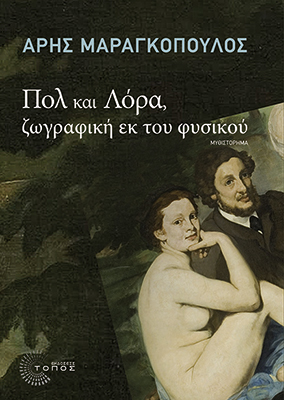 |
Paul et Laura, tableau d'après nature
Maragkopoulos Aris Pages: 528
Shape: 17X24
ISBN: 978-960-499-204-1
Price: 18.90 €
::. Historical Novel
::. Political Fiction
|
|
Α novel inspired by the lives of Paul Lafargue (1842-1911) and his wife Laura Marx (1845-1911), based on the history of the second half of 19th and the first decade of the 20th centuries.
Paul Lafargue, was a French revolutionary (marxist socialist) journalist, literary critic, political writer and activist; he was Karl Marx's son-in-law having married his second daughter, Jenny Laura Marx, better known as Laura Marx (in 1868). His best known work is The Right To Be Lazy. Born in Cuba to French and Creole parents, Lafargue spent most of his life in France, with periods in England and Spain. At the age of 69, he and 66-year-old Laura died together by a suicide pact.
The fictional life of these two characters serves as a concave mirror in the novel reflecting the tumultuous development of capitalism in the second half of 19th century.
The novel juxtaposes the revolutionary political reading of the world by the activist doctor Paul Lafargue to the revolutionary artistic reading of the world by the painter Édouard Manet and, more specifically, The Right to be Lazy essay (1883) of the first to Le Déjeuner sur l'herbe painting (1863) by the second.
With this position as a starting point the writer delves into the psychology of a middle-class Laura Marx vis-a-vis the warm temperament of a half creole Paul, from their early twenties and their love affair under the roof of the Marx's house, to the end of their lives after almost half a century, at their house at Draveil, in the outskirts of Paris.
The plot of the novel is mainly focusing οn the developing psychology of these dramatic figures from their enthusiastic and visionary twenties to their more sombre old age; their constant struggle to survive against all kinds of financial and social difficulties, their disappointment and ensuing melancholy (especially Laura's) after losing their three children in a short period of a few years; their demanding social vision for the future along with their anxiety to disseminate their father and father-in-law's social thought in France in a period of continuous social upheaval and political repression by the rising bourgeois class – as well as their personal conflicts arising from the above family and social background.
The standard belief of Paul in the right of people to be "creatively lazy" as a result of his personal pursuit of "la joie de vivre" serves as a leitmotiv in the novel. Yet, the central leitmotiv is the "after nature" depiction of events (starting from the "Ut Pictura Poesis" theory as supported by Horace through Johann Joachim Winckelmann and argued by Gotthold Ephraim Lessing – in the novel this theory is commented by Marx and Engels during a Christmas dinner) which implies, in more than one ways, the infinite possibilities of re-reading history in perspectives quite different from the established ones.
The "after nature" leitmotiv plays an important role in making the reader understand (through modernist narrative techniques with emphasis on polyphony / unfinalizable characters, the way M.M. Bakhtin's theory has analysed them) a historic period of European history during which, truth, in every application of the word from politics to culture, seemed for the first time in modern history to be simply and bluntly replaced by truthfulness.
The interesting thing about this novel -which all critics underline- is that it brings together the utopian dreams of socialist activists like Paul Lafargue, dreams which revolutionised the society of the second half of the 19th century, with the radical new approach of artists like Édouard Manet whose original work revolutionised in its turn the culture and art of the same period.
|

